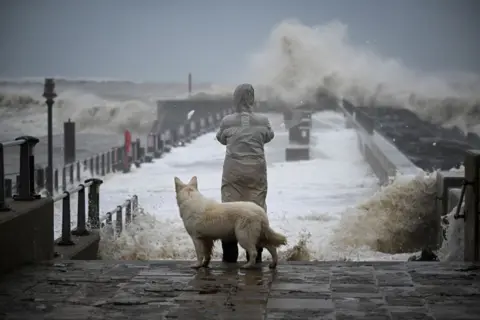 EPA
EPAClimate change is dramatically increasing the frequency of extreme high temperatures in the UK, new Met Office analysis has confirmed.
Its annual State of the Climate report says data from 2023 shows the country is experiencing significantly more really hot days.
Its observations suggest there has been an increase in the number of really wet days too, such as the prolonged and heavy rain Storm Babet brought to wide areas of the country in October last year.
The report finds the UK is also seeing a 40% increase in the number of what the Met Office describes as “pleasant” days – those with temperatures of 20C or more – and has become 9% sunnier over the last few decades.
Those changes may sound positive, but the UK’s shifting climate represents a dangerous upheaval for our ecosystems as well as our infrastructure.
For example, between 1961 and 1990 only London and Hampshire recorded six or more days a year with temperatures over 28C – which the Met Office defines as “hot days”. By the latest decade (2014-2023) virtually everywhere in England and Wales was seeing this many hot days, while the South East now gets over 12 in a year.
The increase in the number of “very hot days” of 30C or more has been even more dramatic, trebling over the last few decades.
Rainfall patterns vary much more than temperature, but the Met Office says it is still possible to identify an increase in the frequency of the wettest days. It looked at the top 5% of wettest days in the period 1961 to 1990 and found extremely wet days like these were occurring 20% more frequently in the most recent decade.
“Some of the statistics in this report really do speak for themselves,” said lead author and Met Office climate scientist, Mike Kendon. “The climate is not just going to change in the future, it is already changing.”
The new report confirms 2023 was the second warmest year on record for the UK, had the hottest June ever recorded and the joint warmest September. Separate studies by Met Office scientists found all these events were made much more likely to happen because of human-induced climate change.
February, May, June and September 2023 were all ranked in the top-ten warmest on record in the UK for the same months in a series dating back 140 years.
The Met Office says there has been a rapid increase in the frequency of record-breaking warm temperatures in recent years, while there have been virtually no new records for cool weather. For the UK overall the warmest months on record have been May 2024, June 2023, December 2015 and April 2011. The last record cold month was December 2010.
 AFP
AFPThe State of the Climate report finds 2023 was the seventh wettest year on records going back to 1836. March, July, October and December were all amongst the top-ten wettest for the same month in the series.
It is these weather extremes – of heat or rainfall – that have the biggest impact on people, says Prof Liz Bentley, the Chief Executive of the Royal Meteorology Society.
“These changes are leading to more heatwaves and flooding, which profoundly impact communities by straining healthcare systems, damaging infrastructure, and disrupting daily life”, says Prof Bentley.
Other significant weather events include seven consecutive days with temperatures above 30C in September – a UK first. Unusually the hottest day of the year was also recorded in September (33.5C on 10 September).
Scotland had its wettest two days on record on 6 and 7 October in a daily series dating back to 1891, with 6.5cm of rain – almost 40% of the average you would expect for October.
 Getty Images
Getty ImagesStorm Babet was the single weather event with the most impact during the year. It hit the country between 16 and 21 October, bringing widespread prolonged and heavy rainfall.
And the country had a very dramatic near miss too. Storm Ciaran had the potential to be as severe as the “Great Storm” of 16 October 1987, says the Met Office. Winds of up to 100 mph (160 km/h) killed 21 people across Europe when it struck in early November 2023, but the UK was lucky, the strongest winds bypassed the country to the south.
The report came as the record for the world’s hottest day tumbled twice in one week, according to the European climate change service.
On Monday the global average surface air temperature reached 17.15C, breaking the record of 17.09C set on Sunday.
It beats the record set in July 2023, and it could break again.
Climate change has already made extreme weather events, such as heatwaves, heavy rainfall, storms and droughts, more frequent and stronger in many parts of the world. Scientists say they these events will become more intense and happen more often unless the world can make dramatic reductions in greenhouse gas emissions.
 Getty Images
Getty Images

